CT4-V Blackwing: Tuning
It depends on the dealership and how the tuning was performed. Our current JB4 and DCM products may be removed in just a few minutes, leaving no trace. However, it’s always prudent to assume that any future powertrain repairs after your modifying your vehicle will be out of pocket expenses.
- Unfortunately, now that Global B has taken over, inexpensive tuning is extinct, just like dinosaurs. No one has access to tune the new E99 ECMs natively. If someone did, they would have already sold thousands of tunes to the C8 Corvette crowd.
- Tapout Tuning's first two complete CT4-V Blackwing performance packages range from $730 to $2,766 for a simple tune to the Blue Belt level. But these aren’t just ‘tunes’. They are properly engineered, validated packages that include EVERYTHING you need: the JB4 (computer), four different calibration maps for 91, 92 and 93 octane fuels, DTC Assassin™ (for clearing DTCs), high performance air filters, ported throttle body, performance spark plugs and resonated downpipes.
- Our team spent more than one year developing these packages for this platform, since no other tuning options and/or performance parts are available. If you’re looking to go cheap and simple and want to stick with GM, then you’ll need to consider getting a pre-Global B car.
CT4-V Blackwings use the E99 ECM with Global B security.
It depends on how much boost you are targeting and how high of ethanol content you would like to run. The low pressure side of the Blackwing fuel system is substantially stronger than the ATS-V fuel system and can technically handle ethanol fuel blends without issue. However, you will need to add a fuel cam to boost the high pressure fuel system capacity. You’ll also need an alcohol content sensor and electronic device to convert the frequency output into an analog voltage. Finally, you’ll need one of our Delta Control Modules and custom tuning, in order to have boost, fueling and timing optimized by ethanol content. These mods will be released in the near future as part of our Purple Belt Performance Package.
We started working with TDI to beta test this unit back in August 2021, the very first week the CT4-V Blackwings were released to the public. After collaborating with their engineers for some hardware and software revisions, the best results were 435 whp and 473 wtq, for modest increases of 24 whp and 27 wtq.
- Their tuning box did function, but the electronics were nowhere near sophisticated enough to produce strong results, and/or allow any sort of tunability. This company was excellent to work with, and we agreed not to bring their product to market based on the results. They also said they might want to revisit this in a couple of years when more sophisticated electronics become available.
- In summary, we discovered that standard piggyback modules which intercept one or two sensors are nowhere near sophisticated enough to use for tuning the newest GM cars.
They claim that their chip starts remapping the ECM as soon as you plug their device into your OBD2 port. After driving about 125 total road miles, their tuning chip will adjust itself to your vehicle’s engine and your driving habits, and continually remap your ECM for optimal performance and fuel consumption. We spent the 52 weeks (from August 2021 through August 2022) trying to find a way to 'tune' the CT4-V Blackwing, and we can tell you there is zero chance their plug-in module can modify signals sent to the ECM via the OBD2 port on the fly. That's simply not how things work in this platform.
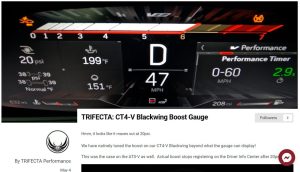 The factory rates these cars at 3.9 seconds with the A10 transmission, and one tuner has claimed a 2.9 second 0 to 60 mph time. The laws of physics tell us that it takes approximately 260 more horsepower to improve the 0 to 60 mph time of a 3,800 pound car from 3.9 to 2.9 seconds. Maybe they did the 0 to 60 time on their dyno. Maybe it was Photoshopped. In either case, this is deceptive to customers and a disservice to the community.
The factory rates these cars at 3.9 seconds with the A10 transmission, and one tuner has claimed a 2.9 second 0 to 60 mph time. The laws of physics tell us that it takes approximately 260 more horsepower to improve the 0 to 60 mph time of a 3,800 pound car from 3.9 to 2.9 seconds. Maybe they did the 0 to 60 time on their dyno. Maybe it was Photoshopped. In either case, this is deceptive to customers and a disservice to the community.
You’ll set DTC P1101 for MAF test out of range from time to time. You’ll also set DTC P0420 and 0430 for catalyst inefficiency if you go with the resonated downpipes. None of these codes cause any side effects or Reduced Engine Power mode. They just light the Check Engine Light, which you’ll be able to clear within two seconds using the DTC Assassin™.
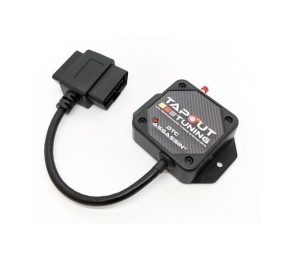

In order to tune the new CT4-V Blackwings with E99 ECM and Global B security, we have to trick the ECM into seeing no higher than factory boost levels. When we tune your car, you’ll definitely have more boost, but the ECM won’t know, and your boost gauge will read pretty close to stock.
CT4-V Blackwing: JB4 Tuner
Yes, all driving modes will work the same as they do now. Below 3,000 rpm, the car will feel completely stock in all modes. Above 3,000 rpm, you’ll have more boost and power than before.
The JB4 does not change any factory ECM settings. So you can easily remove the JB4, leaving no trace behind.
No, we still don’t have ECM access, so there is no way to disable DTCs or eliminate Check Engine Light with aftermarket downpipes yet.
There is no way a dealership would be able to detect the JB4 had been previously installed.
RR12YS or RR12S will work fine. RR12YS may last a little longer. RR12S will perform a little better.
Yes, we pre-gap them to .027”. However, the gaps should be double checked prior to installation.
We will include separate calibration maps for 91, 92 and 93 octane. You can switch between them in very easily via the JB4 cell phone app.
We’re still working on finalizing all the details for our Purple and Brown Belt Performance Packages, which will run E85 fuel.
You can deselect any items you already purchased when you place your order.
You can install it yourself, or you could bring the car to our shop here in Ohio if you prefer.
https://www.tapouttuning.com/frequently-asked-technical-questions-for-ct-4-blackwing/We have not tested the JB4 tuner in extreme temperatures. However, we have tuned the same LF4 engines in hundreds of ATS-Vs all over the world. Many are in Dubai, and that’s one of the hottest regions in the world. Plus, the CT4-V Blackwing has a significantly improved cooling system. You can learn more about that HERE.
They are completely distinct products from different manufacturers, with different electronics, different software, different sensor taps, different user interface and different custom tuning ability. The only thing they have in common is that they both allow the cars to be tuned outside of the ECM.
We have been working on our in house dynamometer, and have completed 225 full throttle Blackwing pulls to date. We have spent considerable time and effort testing and validating the JB4 product for the CT4-V Blackwings, and are currently developing and refining their calibration maps for the perfect combination of increased power, while still retaining safety and reliability. Other tuners who haven’t done the proper testing may elect to turn the knobs up higher than we do, but they don’t really care about the longevity of your engine.
If you want to create your own calibration, you can use Map 6 and edit via your cell phone app.
Don’t worry. We can take care of your engine replacement on site 😉
We’re working on it right now, but cannot give a precise E.T.A. at this time.
When you’re not in the gas, the tunes will perform identical to stock. So the car will still be totally fine on long road trips.
Bolt-ons do not typically increase horsepower for untuned CT4-V Blackwings, since the ECMs are torque based. If you install something that helps the engine to flow more air, the ECM just commands a little less boost, and power output remains the same. This is why all our CT4-V Blackwing Performance Packages include both parts and tuning.
CT4-V Blackwing: Engine
The factory CT4-V PCV system is excellent, and works totally fine, even on our 747 whp flagship car. So we don’t offer or recommend any sort of aftermarket catch can.
One tuning company recently reported that CT4-V Blackwings have fuel injectors that are 9% larger than those found in ATS-Vs. This information is false. All LF4 engines use the same fuel injector (part number 12622473). We already researched this 21 months ago when the new Blackwings were first released.
Bolt-ons do not typically increase horsepower for untuned CT4-V Blackwings, since the ECMs are torque based. If you install something that helps the engine to flow more air, the ECM just commands a little less boost, and power output remains the same. This is why all our CT4-V Blackwing Performance Packages include both parts and tuning.
- When the engine is first started, there a boost limiting timer within the ECM that limits boost while the engine is warming up. If you've been around a while, you might remember that everyone who ever raced ATS-Vs had to let their cars idle for a few minutes before racing, until Tapout Tuning paid a German hacker to locate these hidden tables for the benefit of the LF4 community. Before this, if you didn't wait until the timer expired, your car might be a full second (or more) slower in the quarter mile.
- Next, the ECM will always modulate the electronic throttle position (and boost indirectly), in order to never exceed the factory torque specification by more than one percent. Then of course, there are all sorts of other torque reduction activities that take place for transmission protection, etc.
- Take a look at the before and after boost curves on this 2022 CT4-V Blackwing we recently tuned. In stock form, boost ranged from 9 to 13 psi in seventh gear on the dynamometer. However, keep in mind that peak boost numbers will vary by transmission gear, atmospheric conditions and other factors.
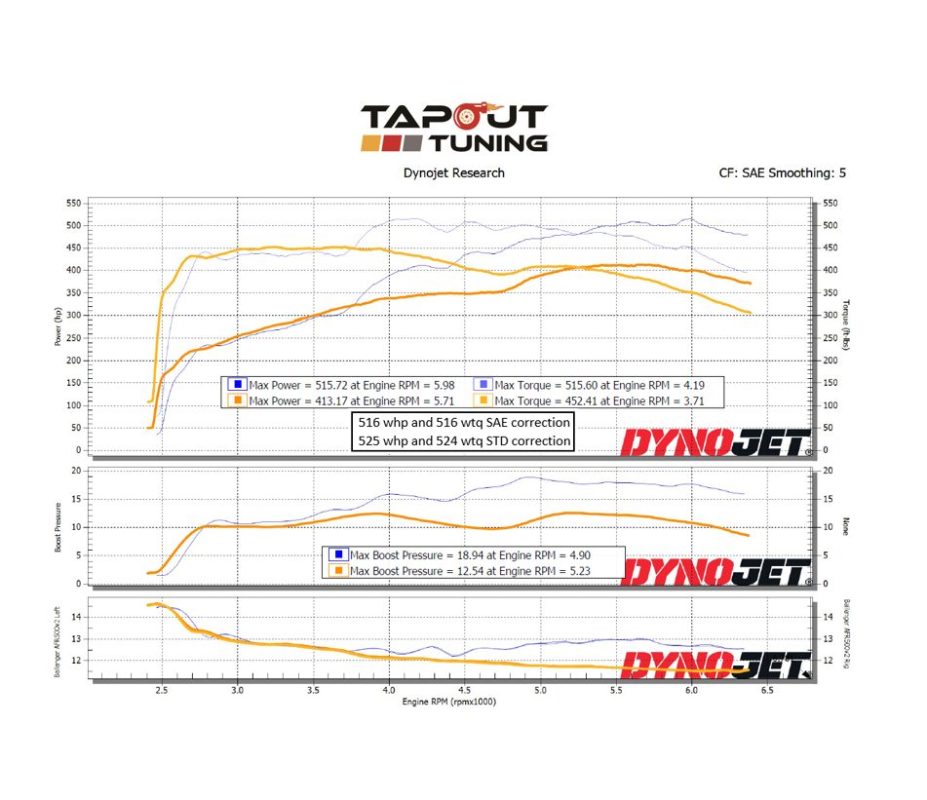
The CT4-V Blackwing has no an alcohol content sensor onboard, so the ECM cannot detect alcohol content. However, the car does have wideband oxygen sensors on both banks in the primary locations. If you add ethanol to your tank, the widebands will sense the mixture change and the ECM will increase short and eventually long-term fuel trims (STFTs and LTFTs). Almost instantaneously, your fueling will be right on the money. However, there are a couple drawbacks to running ethanol fuel blends in these cars without proper tuning. First, since the ECM is torque based, it will not produce any more on ethanol fuel blends than it will on pump gas. And second, your LTFTs will peg around 30%, which is typically somewhere between E40 and E50 ethanol content. So we recommend normal high octane pump gas (E0 to E15) for stock CT4-V Blackwings, and those running our White and Blue Belt Performance Packages. We will start taking advantage of the performance benefits of ethanol fuels in the near future when we introduce our Purple and Brown Belt Performance Packages.
- Yes, the CT4-V Blackwing has a much improved intercooler system, even though overall system capacity has been reduced from 3.3 to 2.9 quarts. In summary, this system was designed for the CT5-V Blackwing and got dropped into the CT4-V Blackwing with way less power. Even with 26 pounds of boost and nearly 700 whp, our flagship CT4-V Blackwing’s factory intercooler has no problem keeping up.
- Check out the dyno chart here.
- The heat exchangers are new, with cores almost twice as large as the ones on the ATS-V, and more efficient too, no longer having the hibachi grill on the side coolers that restricted flow. These are now manufactured in house by a GM subsidiary in the U.S.A. The air flow to the coolers themselves is so much more efficient, in that every radius in the grille mesh, surfaces has been dialed in to ensure air is hitting as much of the area of the heat exchangers as possible, including tilting the transmission cooler to expose the bottom 2” of the main radiator to fresh airflow. The intercooler pump design changed due to the new electrical architecture that provides much more control via the ECM, and again, it’s a pump designed or the big V8s and used on the small car. There is a Y in the pipes on top of the engine is actually called a mini reservoir and it has a screw on top to make bleeding that circuit way simpler. There is also a ‘tower’, which serves as a small reservoir to catch any air in the system and trap it which results in overall better efficiency of the system. Overall GM designed the pipes to be less distance, less fluid (mass) but also flow more efficiently and allow significantly better air bleeding/less trapping.
- Speaking of cooling overall, the radiator shroud for the fan is unique to Blackwings, with two added doors/flaps that open to make it more efficient, and they also tuned the stiffening ribs of it to not restrict airflow but stay stiff enough to meet modals required. The main radiator is all different and is not sectioned like the ATS-V was. The new CT4-V Blackwing engine cooling system includes the main radiator and the left hand side auxiliary radiator for the charged air system. The new CT4-V Blackwing charged air intercooler system includes the main/center/front low temperature radiator and the right hand side auxiliary radiator. Then there is the core that lays horizontal, which is used for transmission and differential cooling.
- Special thanks to @Mirza Grebovic and his team for the excellent design work, and for helping our team to understand all the cooling system improvements.
On LF4 engines, the right/passenger side bank is the farthest forward. That's what makes the right side of the engine 'bank 1'. The right front cylinder, closest to the coolant bottle, is cylinder one (1). On the right/passenger side, the cylinders are numbered 1-3-5, from front to rear. On the left/driver side they are numbered 2-4-6.
We run any brand of 5W30 synthetic for all 'normal' street cars. In hotter climates like Florida, Texas and southern California we recommend 5W40. Above 700 whp, we recommend 5W50 racing oil with lots of zinc.
Stock LF4 spark plugs are AC Delco 41-147, 12662396, iridium, gapped between .030 and .035″. Most people tuned for higher boost are running one or two heat ranges colder than stock, gapped a little tighter. We recommend Brisk Silver Racing Plugs that come pre-gapped. When you replace the spark plugs, always apply dielectric grease (included with our Brisk plugs) on the inside of the coil pack connector boots. This will displace the air and prevent carbon tracking. Recommended torque value when installing in aluminum cylinder heads is 8 to 14 foot-pounds. You can buy them here.
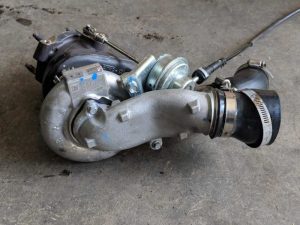 The OEM LF4 turbochargers are Mitsubishi TD04L6 models with 20TK3S compressor wheel. These units can effectively support 275 to 350 crankshaft horsepower per turbo, which works out to approximately 640 whp on the dyno. They just can’t move more air than that, so realistically there’s no more power to be made.
The OEM LF4 turbochargers are Mitsubishi TD04L6 models with 20TK3S compressor wheel. These units can effectively support 275 to 350 crankshaft horsepower per turbo, which works out to approximately 640 whp on the dyno. They just can’t move more air than that, so realistically there’s no more power to be made.
- 13 to 15 psi is stock for lower altitudes. Those at higher elevations will likely see less.
- 17 to 20 psi is what you can expect with our White and Blue Belt Performance Packages.
- 21 to 24 psi will be the range for our Purple Belt Performance Package.
- 25 to 30 psi may be run with our Brown Belt Performance Package.
CT4-V Blackwing: General
140 foot-pounds or 190 Nm
- Engine oil: ACDelco dexos1 full synthetic, 5w30 (7.0 quarts with filter)
- Engine coolant: 50/50 mixture of DEX-COOL with clean drinkable water (14.4 quarts for engine, plus 2.9 quarts for intercooler)
- Mobil 1 Synthetic LV ATF HP transmission fluid, GM part number 19417577 and its blue colored label. Do not use the black bottles or grey labeled HP fluids as those contain earlier formulations that cause TCC shudder in some cases.
- M6 manual transmission fluid: manual transmission fluid, GM part number 88861800, 88861801 in Canada
- Rear axle and limited slip differential (driver’s side): DEXRON LS gear, 75w90, GM part number 88862624, 88862625 in Canada (1.6 quarts)
- Electronic limited slip differential (passenger’s side): DEXRON-VI automatic transmission fluid (0.149 quart)
- Hydraulic brake and clutch system: DOT 3 hydraulic brake fluid
If you have run your car in the eighth mile and want to know how it will perform in the quarter mile, simply multiply your time by 1.555. All the ATS-V time slips we have data for show a ratio between 1.530 and 1.560. Ratios on the lower end of that range normally indicate a front half problem such as starting line traction or a missed 1-2 or 2-3 shift in the case of a manual transmission. Ratios on the upper end of that range tend to imply a back half problem such as knock retard, boost drop-off or a missed 3-4 shift in the case on an M6 car.
Emissions rules and testing varies by state and even county, and we are not familiar with all the rules in each geographic location. Some areas just check to see if you have a Check Engine light, and/or plug a scan tool into the diagnostic port to check DTCs and readiness monitors. Others do a visual inspection. And some even go as far as putting a sniffer into one of the tailpipes. You may want to post in some of the various internet groups on Facebook and ask how others handle emissions testing in your area.
Final production numbers for the 2022 model year were 1,127 with A10 and 664 with M6 transmission, for a total of 1,791 cars.
- Any time there are misfires at WOT, these cars (ATS-Vs and CT4-V Blackwings too) will sometimes present a ‘Service Rear Axle’ light on the dash. No one outside of GM really understands why, but this has been fairly common since 2016.
- That said, we don’t want misfires at WOT on your car. However, no good diagnostic tools exist for these new cars with Global B. So we’re forced to guess a little bit until we find the root cause of the problem.
- The most obvious cause of WOT misfires would be hitting the rev limiter. Cars with increased boost and more power are much more likely to hit their rev limiters, since we don’t have access to shift points and/or rev limiter settings. This can easily be tested by manually shifting the car earlier and seeing if the problem disappears. That’s how we circumvent the issue with our flagship car.
- The second most likely cause of misfires at WOT is spark plugs. When boost is increased, it’s critical that colder spark plugs, with smaller gaps, be installed using plenty of dielectric grease in the coil boot ends. If this isn’t done correctly, WOT misfires will result within a few hundred miles due to carbon tracking. We show how to do it on our website HERE.
- The third most likely cause of misfires at WOT would be knock retard. This happens whenever there is more boost and/or ignition timing than your fuel octane can support. However, there is currently no way to log this parameter in the field on Global B cars. You can test this by increasing your fuel octane. If you already run 93-octane fuel and no higher octane is available, try a different gas station. This has resolved issues for many people. If you still have the same problem, try turning down your ‘tune’. In JB4, you can switch from Map 1 to Map 0. Or stay on your current map and reduce all the numbers in the Fuel Bias column by 5 or 10%.
CT4-V Blackwing: Modifications
White Belt Performance Package includes an electronics module that plugs into your sensors under the hood, plus a dongle that plugs into the OBD2 port under your dash, and high performance air filters. Blue Belt Performance Package includes the same items as White Belt, plus ported throttle body, and spark plugs. Purple Belt will include fuel system modifications to support ethanol fuel blend. Brown Belt will add ARP head studs and the record setting Caddy Issues modified turbochargers.
- All tuned CT4-V Blackwings will set DTC P1101 for MAF test out of range from time to time. There are no side effects or Reduced Engine Power mode. This nuisance code just lights the Check Engine Light every now and then, which you’ll be able to clear within two seconds using the DTC Assassin™.
- If you choose to run resonated downpipes, you’ll also set DTC P0420 and 0430 for catalyst inefficiency. There are no side effects or Reduced Engine Power mode. These codes just light the Check Engine Light, which you’ll be able to clear within two seconds using the DTC Assassin™.
- If you’re running the Purple or Brown Belt Performance Package, you will need to limit your ethanol content to somewhere in the E40 to E50 range. Above a certain threshold, your long-term fuel trims (LTFTs) will peg around 30%, and you’ll set DTC P0171 and/or P0174.
ATS-Vs are tuned via direct access to more than 2,500 calibration tables within the ECM. This gives us complete control over all aspects of tuning. It’s impossible to tune the computers on newer vehicles with Global B security like the CT4-V Blackwing. So the only choice we have is to use external electronics to intercept and modify sensor signals. This allows us to turn up the boost to some degree. However, we are still limited by the ECM in many regards. For example, we cannot increase the rev limiters, edit torque limits, alter fuel injection timing, adjust variable valve timing or disable DTCs. These tuning limitations in turn exclude certain aftermarket modifications, such aftermarket camshafts.
Due to Global B, we have far less tuning ability in the ECM. For example, we cannot increase the rev limiters, edit torque limits, alter fuel injection timing, adjust variable valve timing or disable DTCs. We are also unable to access the TCM to permit second gear starts, edit shift points, etc. And finally, the new Blackwings are also slightly more than 100 pounds heavier than ATS-Vs.
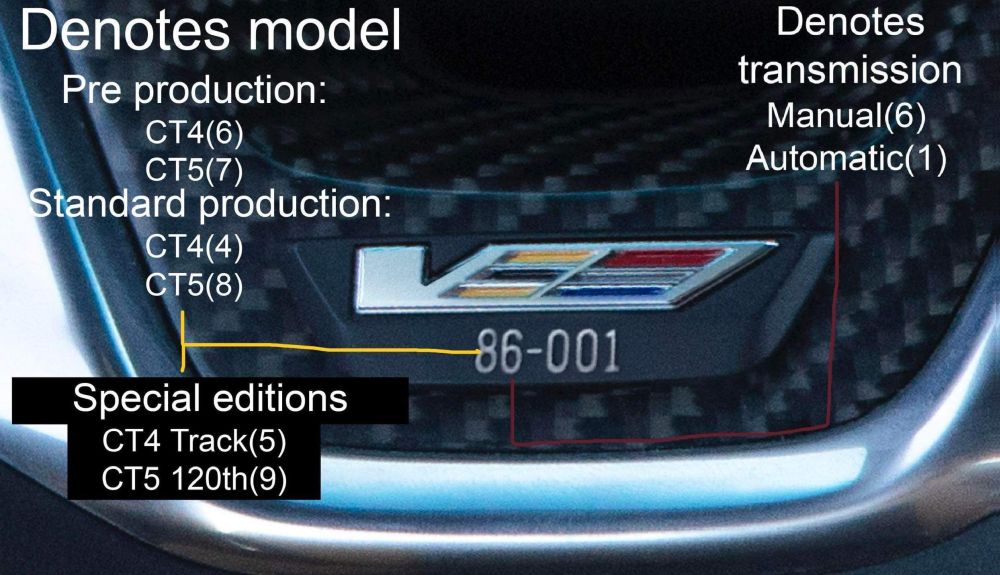
Follow Us